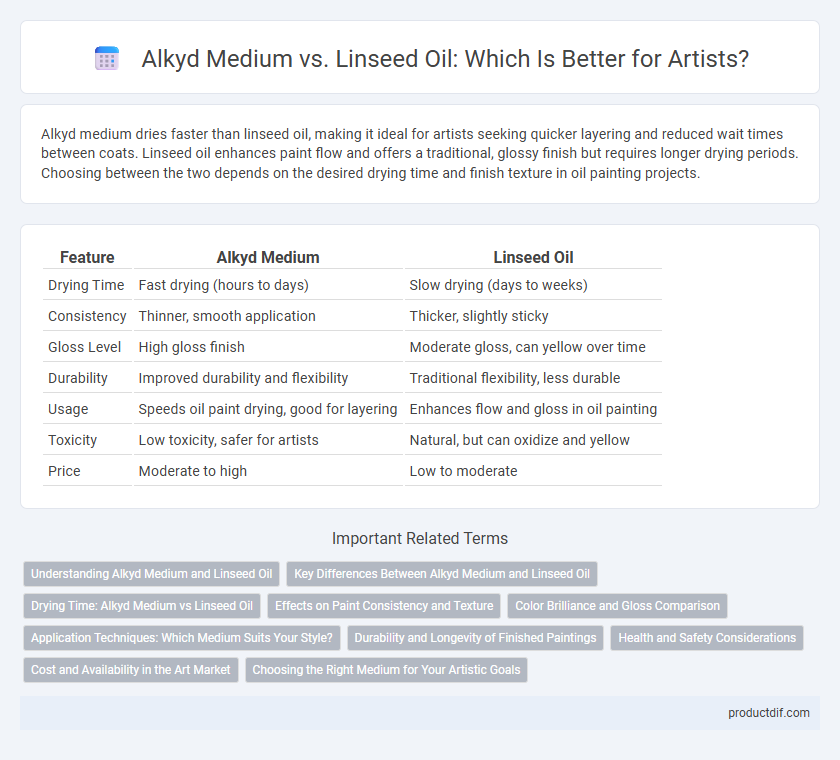Alkyd medium dries faster than linseed oil, making it ideal for artists seeking quicker layering and reduced wait times between coats. Linseed oil enhances paint flow and offers a traditional, glossy finish but requires longer drying periods. Choosing between the two depends on the desired drying time and finish texture in oil painting projects.
Table of Comparison
| Feature | Alkyd Medium | Linseed Oil |
|---|---|---|
| Drying Time | Fast drying (hours to days) | Slow drying (days to weeks) |
| Consistency | Thinner, smooth application | Thicker, slightly sticky |
| Gloss Level | High gloss finish | Moderate gloss, can yellow over time |
| Durability | Improved durability and flexibility | Traditional flexibility, less durable |
| Usage | Speeds oil paint drying, good for layering | Enhances flow and gloss in oil painting |
| Toxicity | Low toxicity, safer for artists | Natural, but can oxidize and yellow |
| Price | Moderate to high | Low to moderate |
Understanding Alkyd Medium and Linseed Oil
Alkyd medium is a fast-drying synthetic resin commonly used in oil painting to speed up drying times and enhance gloss and durability. Linseed oil, derived from flax seeds, is a traditional binder valued for its flexibility, slow drying time, and ability to deepen color richness in paint. Understanding the differences helps artists choose between quicker drying with alkyd mediums and the classic texture and finish provided by linseed oil.
Key Differences Between Alkyd Medium and Linseed Oil
Alkyd medium dries significantly faster than linseed oil, reducing drying time from days to hours, which is crucial for artists seeking quick layering. Unlike linseed oil, alkyd medium offers a more durable, flexible film with less yellowing over time, enhancing artwork longevity. Linseed oil provides a traditional, glossy finish with slower curing, allowing extended blending, whereas alkyd mediums create a less glossy but more stable surface ideal for quicker workflows.
Drying Time: Alkyd Medium vs Linseed Oil
Alkyd medium significantly reduces drying time compared to traditional linseed oil, allowing oil paints to dry within 24 to 48 hours versus several days or weeks with linseed oil. This accelerated drying process enhances workflow efficiency for artists seeking faster layering and glazing techniques. Alkyd medium's fast-drying properties make it a preferred choice for time-sensitive projects without sacrificing the durability and finish associated with oil painting.
Effects on Paint Consistency and Texture
Alkyd medium accelerates drying time and enhances paint flow, resulting in a smoother and more fluid consistency ideal for glazing and layering. Linseed oil thickens the paint slightly and increases its gloss, providing a richer texture with slower drying suitable for blending and extended workability. Choosing between alkyd medium and linseed oil impacts paint texture, drying speed, and handling characteristics essential for different painting techniques.
Color Brilliance and Gloss Comparison
Alkyd medium enhances color brilliance by accelerating drying time and maintaining vibrant pigments, resulting in a glossier finish compared to linseed oil. Linseed oil offers a more subtle gloss with a slightly yellowish tint over time, which can mellow color vibrancy. Artists seeking intense gloss and sharper color retention often prefer alkyd mediums for their superior clarity and quicker curing properties.
Application Techniques: Which Medium Suits Your Style?
Alkyd medium offers faster drying times and smoother brushwork, ideal for artists seeking quick layering and detailed textures. Linseed oil provides a slower drying process, enabling extended blending and richer glazing techniques suited for traditional oil painting styles. Choosing between alkyd medium and linseed oil depends on whether your technique prioritizes speed and precision or extended working time and depth.
Durability and Longevity of Finished Paintings
Alkyd medium enhances the durability and longevity of finished paintings by accelerating drying time and creating a tougher, more flexible surface resistant to cracking. Linseed oil, while traditional and offering rich gloss and depth, dries slower and may yellow or become brittle over time, potentially compromising the painting's lifespan. Artists seeking extended preservation prioritize alkyd mediums for their superior stability and resistance to environmental factors.
Health and Safety Considerations
Alkyd mediums emit fewer volatile organic compounds (VOCs) compared to traditional linseed oil, reducing inhalation risks and improving indoor air quality during use. Linseed oil can oxidize and become rancid over time, potentially causing skin irritation or allergic reactions, while alkyd mediums generally dry faster and have lower allergenic potential. Proper ventilation and protective gloves are recommended with both substances to minimize exposure to harmful fumes and skin contact, ensuring safer handling in artistic environments.
Cost and Availability in the Art Market
Alkyd medium is generally more affordable and readily available in the art market compared to traditional linseed oil, making it a cost-effective choice for artists seeking quick drying times. Linseed oil, while slightly more expensive and less common in mainstream art stores, remains a staple for its superior glossy finish and longer drying time, which is favored in classical oil painting techniques. The widespread distribution and lower price point of alkyd mediums contribute to their growing popularity among both amateur and professional painters.
Choosing the Right Medium for Your Artistic Goals
Selecting between alkyd medium and linseed oil depends on drying time and finish preferences; alkyd medium offers faster drying and a glossy finish, ideal for artists working on layered techniques or needing quicker results. Linseed oil, prized for its slow drying and rich, flexible texture, suits painters aiming for traditional blending and extended working times. Understanding the specific properties of each medium aligns your choice with desired effects and workflow efficiency in oil painting.
Alkyd medium vs Linseed oil Infographic

 productdif.com
productdif.com